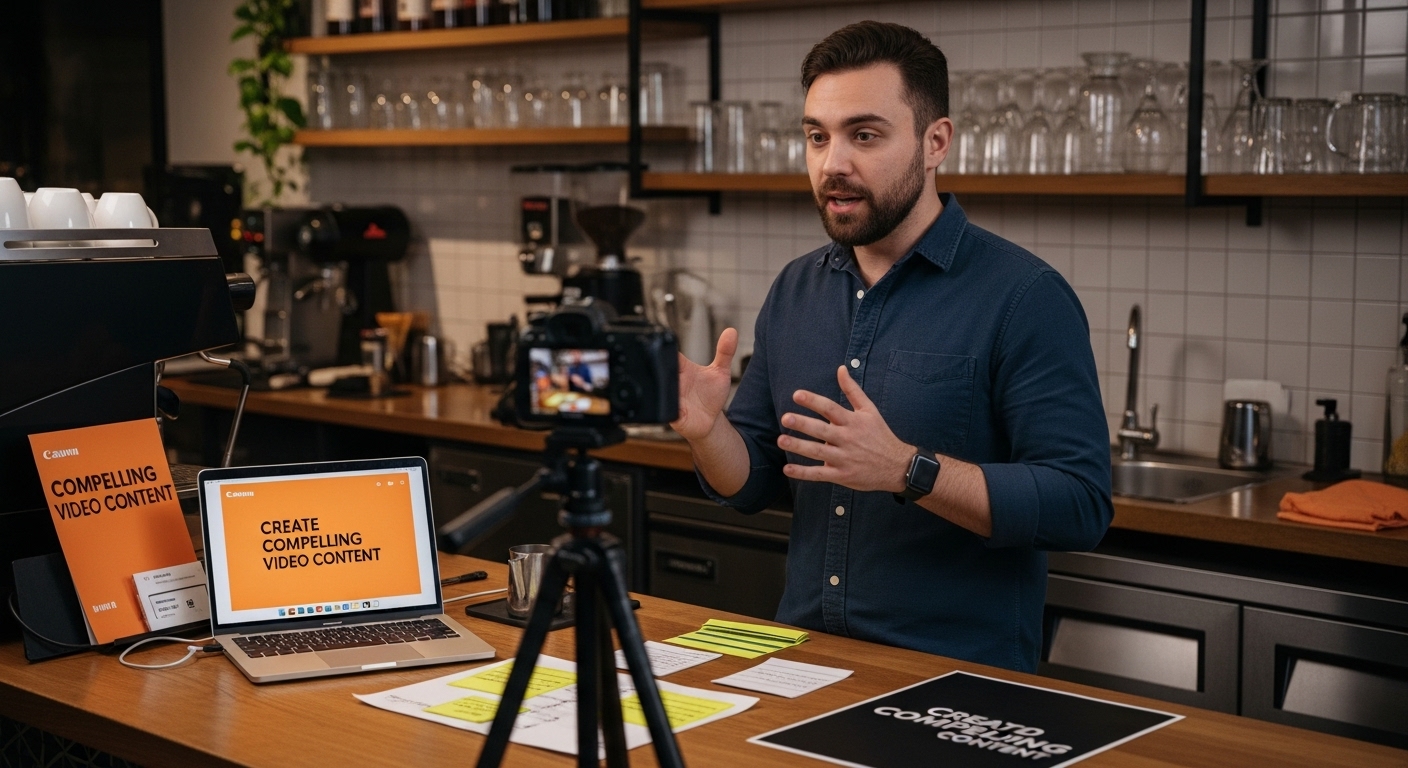Video Marketing Step by Step: Boost Your Business in 2025
- Eddie The Chef

- Sep 12
- 10 min read

Video marketing is taking Aussie businesses to new heights. Whether you want more leads, higher sales, or just to get noticed, your goals will shape every step of the process. You might think picking up a camera is the hard bit. Actually, the real secret is nailing your strategy before you even hit record. That’s where the smart operators stand out.
Table of Contents
Quick Summary
Key Point | Explanation |
1. Set Clear Video Marketing Goals | Define specific objectives to align your content with business vision and audience needs. |
2. Understand Your Target Audience | Create detailed personas representing your ideal customers to tailor video content effectively. |
3. Create Engaging Video Content | Prioritise authentic storytelling and clear messaging to resonate with your audience while being concise. |
4. Optimise Videos for Search Engines | Conduct keyword research and enhance metadata to improve visibility and discoverability of your content. |
5. Measure Results and Adjust Strategy | Use analytics to track performance and refine strategies based on viewer engagement and behaviour. |
Step 1: Define Your Video Marketing Goals
Successful video marketing starts with crystal clear objectives that align with your business vision. Before hitting record, you need a strategic roadmap that transforms raw video content into powerful marketing ammunition. Your goals will dictate everything from content style to distribution channels, making this initial planning phase absolutely critical for your marketing success.
Begin by conducting a comprehensive assessment of your current business landscape. What specific outcomes do you want to achieve? Are you looking to increase brand awareness, drive website traffic, generate leads, or boost sales conversions? Each goal requires a tailored approach. For instance, brand awareness videos look dramatically different from direct sales conversion content. Learn more about video marketing strategies that can help you pinpoint your precise objectives.
Consider your target audience’s preferences and pain points when defining these goals. A healthcare professional might seek educational content explaining complex medical procedures, while a retail business might want engaging product demonstration videos. Your video marketing strategy must speak directly to your audience’s specific needs and interests.

This means understanding their demographics, online behaviour, and content consumption habits.
To validate your goals, establish measurable key performance indicators (KPIs) that will help you track progress. These might include metrics like view count, engagement rate, click-through rate, or direct conversion tracking. By setting quantifiable targets upfront, you create a framework for assessing your video marketing’s effectiveness. Without clear metrics, you’re essentially navigating without a compass.
Remember that goal setting is not a one-time event but an ongoing process. Be prepared to review and adjust your objectives as your business evolves and market dynamics shift. The most successful video marketing strategies remain flexible and responsive to changing audience expectations and technological advancements.
Step 2: Identify Your Target Audience
Understanding your target audience is the foundation of effective video marketing. Without a precise picture of who you’re speaking to, your content will feel like a shot in the dark. Your audience determines everything about your video strategy - from tone and style to distribution channels and messaging.
Start by developing comprehensive audience personas that go beyond basic demographics. These are not just abstract profiles but detailed representations of your ideal customers. According to Australian Government business resources, consider factors like age, income, professional background, interests, pain points, and digital behaviour. For a local cafe, this might mean understanding whether your audience comprises young professionals seeking quick breakfast options or retirees looking for a leisurely afternoon coffee experience.
Dive deep into audience research using multiple tools and techniques. Leverage existing customer data from your sales records, website analytics, and social media insights. Google Analytics can reveal critical information about who currently interacts with your online content. Social media platforms offer robust demographic breakdowns that help refine your understanding. Pay attention to engagement metrics - comments, shares, and interaction rates tell you more about audience preferences than raw view counts.
Conducting direct customer surveys and interviews provides invaluable qualitative insights. Ask your existing customers about their challenges, preferences, and content consumption habits. What types of videos do they find most compelling? When and where do they typically watch videos? Understanding these nuanced details helps you craft video content that resonates authentically. For instance, a tradesperson might prefer short, practical tutorial videos, while a corporate executive might appreciate more in-depth, professionally produced content.
To verify you’ve successfully identified your target audience, create a detailed persona document that includes specific characteristics, behavioural patterns, and content preferences. This living document should be regularly updated as your business and market evolve. A well-defined audience persona becomes your north star, guiding every creative decision in your video marketing journey.
Step 3: Create Compelling Video Content
Transforming your video marketing goals into actual content requires strategic creativity and technical precision. Compelling video content is not about expensive equipment but about telling authentic stories that resonate with your audience. Your videos must simultaneously inform, entertain, and motivate viewers to take action.
Begin by scripting your video with laser-focused intention. Develop a narrative that speaks directly to your target audience’s needs and challenges. For a trades business, this might mean creating a step-by-step repair tutorial. For a cafe, it could be a behind-the-scenes look at your coffee roasting process. Learn more about content marketing strategies that can elevate your storytelling approach.
According to research from the Australasian Journal of Educational Technology, effective videos are typically shorter, segmented, and structured coherently. Aim for concise content that delivers maximum value in minimal time. A 2-3 minute video can often communicate more effectively than a lengthy production. Focus on clarity, using simple language and visual demonstrations that make complex concepts easily digestible.
Invest in basic production quality without breaking the bank. Modern smartphones offer exceptional video capabilities, and free editing software like DaVinci Resolve can help polish your content. Key production elements include good lighting, clear audio, and steady framing. Natural lighting works wonderfully, and a simple clip-on microphone can dramatically improve sound quality. Consider creating a simple home studio setup with a clean background that represents your brand’s aesthetic.
To verify your video content’s effectiveness, develop a comprehensive review process. Watch your draft video from your target audience’s perspective. Does it answer their key questions? Is the messaging clear and engaging? Share drafts with trusted colleagues or a small focus group to gather honest feedback.

Remember that great video content is an iterative process - your first version will rarely be your best, so remain open to refinement and continuous improvement.
Step 4: Optimize Videos for Search Engines
Search engine optimization transforms your video from a hidden gem into a discoverable digital asset. Video SEO is not just about technical tricks but creating content that search algorithms and human viewers find genuinely valuable. Your goal is to ensure your carefully crafted video appears precisely when potential customers are searching for solutions you provide.
Begin with robust keyword research targeting phrases your ideal audience actually uses. Tools like Google Keyword Planner and YouTube’s search suggestions reveal real search behaviors. Instead of generic terms, focus on specific, conversational phrases that reflect user intent. A plumber might target “how to fix a leaking pipe in Melbourne” rather than the broad term “plumbing services”. Explore our comprehensive video marketing statistics to understand search trend nuances.
According to the Australian Public Service Professions website, strategic SEO directs the right users to relevant content. Optimize your video’s metadata meticulously. This means crafting descriptive, keyword-rich titles that accurately represent your content, writing comprehensive video descriptions that include targeted keywords naturally, and selecting thumbnail images that entice clicks. Ensure your video title and description provide clear value propositions within the first 100 characters.
Transcripts and closed captions are often overlooked SEO powerhouses. They provide text-based content for search engines to crawl, improving discoverability while simultaneously making your content more accessible. Many video platforms like YouTube automatically generate captions, but manually reviewing and editing ensures accuracy. Additionally, consider creating a dedicated webpage for each video that includes an embedded video, detailed written description, and relevant supporting content. This multi-format approach signals to search engines that your content is comprehensive and valuable.
To verify your optimization efforts, track key performance metrics. Monitor your video’s search rankings, click-through rates, and audience retention. A well-optimized video should see gradual improvements in search visibility and engagement. Remember that SEO is an ongoing process requiring continuous refinement and adaptation to evolving search algorithms and audience behaviors.
Step 5: Distribute Your Videos Across Platforms
Video distribution is the strategic lifeline that transforms your content from isolated media into a powerful marketing tool. Your carefully crafted video needs a thoughtful roadmap to reach and engage your target audience across multiple digital channels. The right distribution strategy amplifies your message far beyond a single platform’s limitations.
Start by understanding each platform’s unique audience and content expectations. YouTube remains the premier video search engine, perfect for longer educational content. Instagram and TikTok thrive on short, visually engaging clips that capture attention within seconds. LinkedIn works brilliantly for professional and B2B content, while Facebook offers robust targeting options for local businesses. Learn more about evolving social media strategies to refine your approach.
According to research exploring digital communication trends, strategic platform selection is crucial. Tailor your video format and length to each platform’s strengths. A 15-second Instagram Reel requires a different approach compared to a 5-minute YouTube tutorial. Consider platform-specific features like Instagram Stories, YouTube Shorts, or LinkedIn’s native video options. Some businesses create platform-specific cuts of their primary video, ensuring optimal engagement across different channels.
Develop a consistent cross-platform distribution schedule that maintains audience interest without overwhelming them. Use scheduling tools like Hootsuite or Buffer to coordinate simultaneous releases across multiple platforms. Track performance metrics for each platform to understand where your content resonates most. Some platforms might deliver higher engagement rates or better conversion potential depending on your specific industry and target audience.
To help you choose the right distribution platform for your video marketing, the table below compares key Aussie platforms and their typical strengths.
Platform | Best For | Recommended Video Length | Unique Features |
YouTube | Educational & long-form | 2–10 min | Searchable, playlists, SEO rich |
Short, visual engagement | 15–60 sec (Reels/Stories) | Quick interactions, hashtags | |
TikTok | Viral, bite-sized content | 15–60 sec | Trends, soundtracks, effects |
Local business reach | 1–3 min | Groups, targeted ads | |
Professional, B2B content | 1–5 min | Networking, thought leadership |
To verify your distribution strategy’s effectiveness, establish clear benchmarks before launching. Monitor key performance indicators like view count, engagement rate, click-through rates, and audience retention across different platforms. A successful distribution approach should show gradual improvement in these metrics, indicating that your video content is not just being seen, but actively appreciated and shared by your target audience.
Step 6: Measure Results and Adjust Strategy
Measuring video marketing performance is not about collecting numbers, but understanding the story behind those metrics. Your video strategy lives and breathes through continuous analysis and strategic refinement. Without systematic measurement, you’re essentially navigating your marketing journey blindfolded.
Begin by establishing a comprehensive tracking system using platform-native analytics and third-party tools. Google Analytics, YouTube Studio, and social media insights provide granular data about viewer behavior. Key performance indicators to monitor include view duration, engagement rate, click-through rates, conversion metrics, and audience retention. These numbers reveal not just how many people watched your video, but how deeply they connected with your content.
According to Business Queensland’s digital marketing guidelines, tracking customer interactions is fundamental to refining your strategy. Create a monthly reporting dashboard that compares performance across different platforms and video types. Look for patterns - which topics generate the most engagement? What video length seems most effective? Are viewers taking desired actions after watching?
Develop a systematic approach to strategy adjustment. If a particular video style generates higher engagement, double down on that format. If certain topics resonate more strongly with your audience, pivot your content strategy accordingly. Be prepared to experiment, but always ground your experiments in data. A/B testing different video thumbnails, titles, or content styles can reveal nuanced insights about audience preferences.
To verify your measurement and adjustment process, establish a quarterly review cycle. During these reviews, compare current performance against your initial objectives. Have you improved view times? Increased conversion rates? Are you reaching your target audience more effectively? A successful measurement strategy transforms raw data into actionable insights, ensuring your video marketing continually evolves to meet changing audience needs and business goals.
Use this table as a checklist to verify you have completed each key step in your video marketing strategy before moving on to the next stage.
Step | Verification Criteria |
Define Your Goals | Objectives and KPIs documented |
Identify Your Target Audience | Persona document updated |
Create Compelling Video Content | Draft reviewed by team or focus group |
Optimise for Search Engines | Titles, descriptions, captions updated |
Distribute Videos Across Platforms | Scheduled posts per platform |
Measure & Adjust Strategy | Metrics tracked, review cycle scheduled |
Take the Next Step: Transform Video Marketing Into Real Business Growth
Have you put in the effort to set goals, understand your customers, and create helpful video content but still wonder how to actually see results for your business? Many regional businesses share your pain. You are not alone if your videos are not getting enough attention or if tracking the impact across platforms feels complicated. You deserve a tailored video marketing strategy that brings real leads and customer growth—not just more views.

Stop letting your hard work go unnoticed. Let the team at Marketing Recipes Australia help you turn your video marketing into a lead-generating powerhouse. With over 30 years of experience and a proven approach that blends traditional storytelling with the latest digital tools, we guide you through every stage—from identifying your audience to optimising for better visibility and integrating with your other online channels. See how we approach video marketing strategy or visit our main site today. Book a personalised session and start moving from video basics to business success right now—your audience is waiting to connect.
Frequently Asked Questions
What are the key goals to consider when starting a video marketing strategy?
Successful video marketing begins with clear objectives, such as increasing brand awareness, driving website traffic, generating leads, or boosting sales conversions. Your goals will shape the content style and distribution channels you choose.
How can I identify my target audience for video marketing?
Develop comprehensive audience personas that reflect your ideal customers. Consider demographics, interests, pain points, and online behaviour. Utilize customer data, social media insights, and direct surveys to create a detailed understanding of your audience’s preferences.
What are effective ways to create compelling video content?
Focus on scripting your videos to address your audience’s needs and challenges. Keep content concise, engaging, and informative. Combine clear narratives with good production quality, ensuring that lighting and audio enhance the viewer’s experience.
How can I optimize my videos for search engines?
Conduct thorough keyword research to target specific phrases your audience searches for. Optimize your video’s metadata by using descriptive, keyword-rich titles and comprehensive video descriptions. Additionally, include transcripts and closed captions to enhance SEO and accessibility.
Recommended
Comments